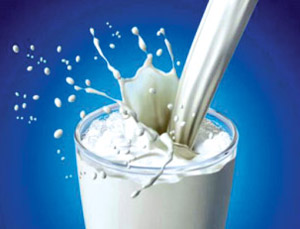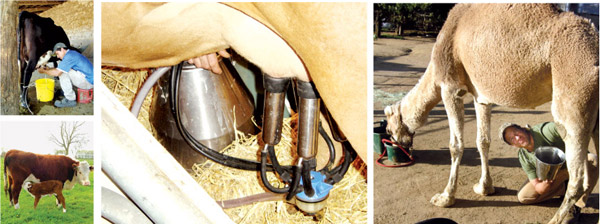|

 Milk
- all humans and all animals in the mammalian order depend on this
nutritious liquid for survival from the moment they are born until they
are weaned of it, at a certain age. Even though the mammals in the
animal kingdom no longer depend on it once they start consuming other
types of food, most adults continue to drink milk or consume milk-based
products known as dairy products, even as adults. Milk
- all humans and all animals in the mammalian order depend on this
nutritious liquid for survival from the moment they are born until they
are weaned of it, at a certain age. Even though the mammals in the
animal kingdom no longer depend on it once they start consuming other
types of food, most adults continue to drink milk or consume milk-based
products known as dairy products, even as adults.
There may be many among you who love to drink milk and eat ice cream,
cheese and yoghurt. Even those of you who do not like to drink milk may
sometimes be forced by your mothers to drink at least a glass of milk a
day because it is essential for your growth.
Milk is not something we pay much attention to because it is
available in abundance in its various forms; as fresh milk, powdered
milk, cream, cheese, ice cream, curd, yoghurt and butter. We eat tons of
food that are made from it. But we have never given a thought as to how
or when milk and dairy products became so important in the human diet.

Tracing the history of milk and dairying is a challenging task, but
many scientists are paying great attention to this today. Keen on
investigating the beginnings of mankind’s long-lasting love for dairy
products, scientists are looking back thousands of years to tackle the
milk mystery. In fact, as some are of the view that dairying probably
transformed societies, they are now looking at the days when humans
first started to milk cows and other animals for use as food and drink.
They are doing this in more ways than one. You will be surprised to
learn that they are not only analysing ancient milk scum (froth) on
extremely old pots, but also looking for clues in the buried bones of
cows, sheep, horses and other milk producing animals (mammals).
Apart from this, they are also tracking down the genes (biological
factors determining inherited characteristics) that allowed people to
digest milk. Now, why are they interested in man’s ability to digest
milk if they are keen on tracing when man first started using it? Well,
there is a good reason for this. As some of you may be aware, even
though most of us consume milk and dairy products, not everyone can
‘stomach’ it. Many get sick from drinking milk and in some countries a
majority of people cannot digest any dairy products. We’ll deal with why
people cannot digest milk and fall ill later, but first let us give you
an explanation as to why scientists are looking at this aspect to solve
the milk mystery. Some scientists believe that by looking at who has the
milk digesting mutation today, they can figure out where and possibly
why milk drinking first started.
The patterns revealed by research are said to be striking. Most
adults in Northern and Central Europe are able to digest milk and this
may be why Sweden, Denmark, Germany and England are popular for dairy
products like cheese and butter. And they also say that the fact that
European settlers dominated North
 America
could be the reason why most people in America can tolerate milk, with
ice cream ending up as a popular dessert in the United States. Native
Americans too are able to digest milk-based products. In contrast
researchers have found that in South America, much of Africa and Asia
most adults tend to avoid dairy products because they lead to various
stomach problems. And so, going by these patterns scientists have always
been of the view that milk drinking started in Europe. After all dairy
production is at a high-level in these countries and the milk digesting
mutation is also everywhere. America
could be the reason why most people in America can tolerate milk, with
ice cream ending up as a popular dessert in the United States. Native
Americans too are able to digest milk-based products. In contrast
researchers have found that in South America, much of Africa and Asia
most adults tend to avoid dairy products because they lead to various
stomach problems. And so, going by these patterns scientists have always
been of the view that milk drinking started in Europe. After all dairy
production is at a high-level in these countries and the milk digesting
mutation is also everywhere.
However, this assumption was challenged by a recent study carried out
by scientists of the University College, London. They used a computer
model to study the spread of the milk-digesting mutation, farming and
other related factors, and working backwards, came to the conclusion
that the first milk drinkers lived in Central Europe (around what’s
known as Hungary today), about 7,500 years ago. So, the practice of
drinking milk did not start further north as they originally believed.
Research has revealed that a farming community known as the
Lineabandkeramik existed around that time in what’s Hungary today and
their culture had spread throughout Northern Europe. A scientist of the
University College, London, Mark Thomas who is involved in the research
believes that milk drinking was probably responsible for the success of
the Lineabandkeramik.
Meanwhile, Richard Evershed, a chemist at the University of Bristol,
United Kingdom and a team of scientists have been analysing pottery
remains from hundreds of ancient vessels in various sites in Europe.
They have also identified dried-up milk fat on the oldest pottery shards
ever found. The shards, dating back 9,000 years have been discovered outside Europe, from an area called the
Fertile Crescent, in the Middle East. The region now includes Iraq,
Syria and Israel. Scientists believe that it is probably where people
first domesticated animals. Some believe milking may have started even
earlier than predicted but, there is no evidence found to this effect,
yet.
years have been discovered outside Europe, from an area called the
Fertile Crescent, in the Middle East. The region now includes Iraq,
Syria and Israel. Scientists believe that it is probably where people
first domesticated animals. Some believe milking may have started even
earlier than predicted but, there is no evidence found to this effect,
yet.
There is also a belief, going by all the evidence found during
research that dairy products were consumed even before people started
drinking milk. Even though there are clues pointing to milk being used
more than 7,500 years ago, no evidence of the gene mutation for
digesting lactose present in milk has been found in the genetic material
pulled out of the bones of early European farmers.
The question that arises then is why produce milk if they couldn’t
digest it? Perhaps, to use it as a base to turn out other food products.
And this means, dairy products were used before people drank milk. But,
how could people stomach dairy products, if they couldn’t drink milk?
Well, it turns out that cheese and other products made out of milk have
less lactose because fermenting and processing removes much of the
lactose in them. And even people who are lactose-intolerant can eat such
products without falling ill.
Scientists are now convinced that the ability to digest milk came
after the skills necessary to produce it. Now they are keen to find out
why people started drinking milk in the first place. Facts and pix:
Internet
*********
Fast facts
* Milk was probably the world’s first superfood says Mark Thomas, a
scientist at the University College, London.
* Milk is spectacular in terms of human nutrition. And if we can have
an animal supply nutrition without killing it, that’s a real step in
agriculture, says Richard Evershed, a chemist at the University of
Bristol in the United Kingdom.
* Milk originally comes from the bodies of mammals. It is produced by
humans as well as all mammal mothers which include cats, dogs, pigs,
mice, horses, camels, sheep and goats, to feed their babies.
* Apart from cow’s milk, which is very popular in most countries, the
milk of sheep, goats camels and horses can also be consumed.
* Each type of milk has a different flavour and some types are easier
to stomach than others.
* Milk drinking does not come naturally to older kids and adults
because some cannot digest it.
* Milk is full of calories, fat, protein, calcium and other
nutrients.
* For ancient man it was a valuable and steady source of food.
* Scientists have discovered a milk-related mutation in our genes -
(the chemical instructions for life we carry in almost every cell in our
bodies.) According to this, people with the mutated form of one
particular gene can drink milk without any problems, but those without
it tend to get sick from milk.
What is lactose-intolerance?
Why are most people unable to drink milk? It is because they cannot
digest lactose which is found in the milk. Milk contains a type of sugar
called Lactose and in order to turn lactose into energy an enzyme known
as lactase is needed. Now if you are not aware as to what an enzyme is,
it is a protein that helps the body do its work.
All human babies and the newborns of mammals have plenty of lactose
and are able to virtually gulp down mothers’ milk without any side
effects. However, lactose levels drop with age, and people can get very
sick from dairy products. Gas, severe stomach problems and diarrhoea are
some of the symptoms of lactose - intolerance. |

